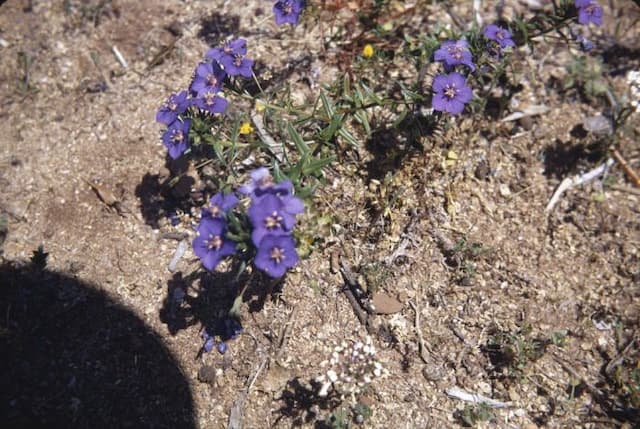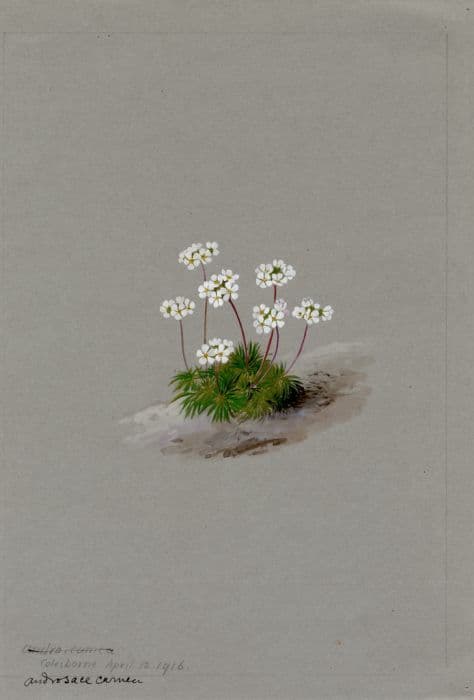Munro's Primrose Primula munroi subsp. yargongensis (Ar)

ABOUT
Primula munroi subsp. yargongensis, commonly referred to as the Munro's Primrose, is a distinct plant notable for its attractive floral and foliar characteristics. The plant typically exhibits a rosette of leaves at its base, which are elongated with a somewhat leathery texture, having smooth edges that may gently wave or undulate. These leaves are green, often with a hint of another color, such as red or purple, particularly on the underside or along the veins. The most eye-catching feature of Munro's Primrose is its flowers. They grow atop thin, straight stalks that rise from the center of the leaf rosette. The blooms are arranged in a whorled fashion, encircling the stalks at intervals and giving the inflorescence a tiered appearance. Each individual flower possesses a vibrant hue that can range from bright yellows to reds, with a tube-like structure and a spreading limb segmented into five rounded lobes that may exhibit a slight notch at the tip. The center of the flower often has a contrasting color, usually a deeper or brighter tone, adding depth and a focal point to each bloom. The Munro's Primrose does not limit its display to the solitary spectacle of blooms; instead, it may produce multiple flowering stems, resulting in a collective display of color that adds to the ornamental value of the plant. The contrast between the flowers and the foliage, along with the overall symmetry and structure of the plant, contributes to its appeal in gardens and natural settings alike.
About this plant
 Names
NamesFamily
Primulaceae
Synonyms
Yargong Primrose
Common names
Primula munroi var. yargongensis (Ar) W.W. Sm. & Forrest
 Toxicity
ToxicityTo humans
Primula munroi subsp. yargongensis, commonly known as primrose, is generally not considered highly toxic to humans. However, some species of Primula can contain primin, a compound that can cause skin irritation in some people. If ingested, Primula plants may potentially cause mild stomach upset as evidenced by nausea, vomiting, or diarrhea. Direct contact with the skin, particularly with the sap, may result in contact dermatitis in sensitive individuals. It is always prudent to exercise caution and avoid ingesting any part of a plant unless it is known to be safe for consumption.
To pets
Primula munroi subsp. yargongensis, commonly referred to as primrose, is not known to be highly toxic to pets. However, as with humans, certain species of the Primula family can cause mild gastrointestinal upset if ingested, which may manifest as vomiting or diarrhea in pets. Contact with the sap may also cause skin irritation in some animals. Therefore, it is recommended to keep this plant out of reach of pets, especially if they are known to chew on plants. If ingestion occurs and symptoms appear, it is advisable to consult with a veterinarian.
 Characteristics
CharacteristicsLife cycle
Perennials
Foliage type
Evergreen
Color of leaves
Green
Flower color
Yellow
Height
0.5 feet (15 cm)
Spread
0.5 feet (15 cm)
Plant type
Herb
Hardiness zones
7
Native area
Asia
Benefits
 General Benefits
General Benefits- Ornamental value: The Primula munroi subsp. yargongensis, commonly known as Yargong primrose, is often used for ornamental purposes due to its attractive flowers and overall appearance.
- Habitat enrichment: Adding the Yargong primrose to gardens or landscapes can contribute to biodiversity and provide habitat for various insects and small animals.
- Pollinator support: The flowers of the Yargong primrose can provide nectar and pollen for bees and other pollinating insects, supporting local ecosystems.
- Erosion control: By establishing a root system, the Yargong primrose can help stabilize soil and prevent erosion in areas where it is planted.
- Seasonal interest: With its flowering period, the Yargong primrose adds seasonal interest to gardens, offering a splash of color in the landscape during its bloom time.
- Educational value: The Yargong primrose can be used for educational purposes in botanic gardens and similar settings to teach about plant biology and horticulture.
- Cultural significance: Some Primula species have cultural importance in certain regions, and their presence can be of cultural or symbolic value to people who appreciate them.
 Medical Properties
Medical PropertiesThis plant is not used for medical purposes.
 Air-purifying Qualities
Air-purifying QualitiesThis plant is not specifically known for air purifying qualities.
 Other Uses
Other Uses- Ornamental Decoration: Due to its attractive flowers, Primula munroi can be used as a decorative element in gardens and floral displays.
- Botanical Illustration: Artists and botanists may use the plant as a subject for detailed botanical illustrations and educational material.
- Educational Tool: Primula munroi can serve as a specimen for educational purposes in botany classes to illustrate plant biology and horticulture.
- Fairy Gardens: The plant's small size and charming flowers make it suitable for use in creating whimsical fairy garden settings.
- Dye Production: Although not commonly known, the petals could potentially be used to produce natural dyes for textile coloring.
- Photography: Primula munroi's unique appearance makes it a captivating subject for photographers specializing in plant and nature photography.
- Culinary Garnish: Edible species of Primula can be used as a garnish for culinary presentations, though the edibility of this subspecies should be verified before use.
- Soil Erosion Control: The plant can be used in certain landscapes to help stabilize soil and prevent erosion due to its root system.
- Companion Planting: Primula munroi might be planted alongside other species as a part of companion planting, which can benefit the garden ecosystem.
- Study of Adaptation: This sub-species, being suited to specific high-altitude conditions, can be used in studies related to plant adaptation and survival.
Interesting Facts
 Feng Shui
Feng ShuiThe Primula is not used in Feng Shui practice.
 Zodiac Sign Compitability
Zodiac Sign CompitabilityThe Primula is not used in astrology practice.
 Plant Symbolism
Plant Symbolism- Renewal - As a species of Primula, often associated with spring and rebirth, Primula munroi symbolizes new beginnings and a fresh start.
- Hope - Similarly to other Primrose family members, this plant may symbolize hope, as it is one of the first flowers to bloom in spring, thus signifying optimism and the expectation of better times.
- Youth - Associated with the vibrancy and delicacy of its flowers, it may represent the beauty and innocence of youth.
 Water
WaterMunro's primrose should be watered once a week with about one gallon of water, ensuring the soil is kept consistently moist but not waterlogged. During the active growing season in spring and summer, you may need to water more frequently especially if the weather is particularly hot or dry. Cut back on watering in the fall and winter when the plant is dormant, reducing to when the top inch of soil feels dry. Always use lukewarm water to avoid shocking the plant's roots.
 Light
LightMunro's primrose thrives in bright, indirect sunlight, so placing it in an east or north-facing window is ideal. It can tolerate morning sun but should be protected from the harsh afternoon sun to prevent leaf burn. If grown outdoors, it prefers dappled shade that simulates its natural alpine habitat.
 Temperature
TemperatureMunro's primrose does best in cooler temperatures, ideally between 60°F and 75°F, and should be protected from extreme heat. It can survive temperatures as low as 50°F, but prolonged exposure below this can harm the plant. Avoid placing the plant near heat sources or in areas where temperatures fluctuate widely.
 Pruning
PruningPrune Munro's primrose after flowering by removing spent blooms and dead or yellowing leaves to encourage new growth and maintain a neat appearance. It is best to prune in late winter or early spring before new growth begins. Pruning can be done on an as-needed basis throughout the growing season to remove damaged or diseased foliage.
 Cleaning
CleaningAs needed
 Soil
SoilPrimula munroi subsp. yargongensis, commonly known as Munro's Primrose, thrives in a soil mix that is well-draining, rich in organic matter, and has a slightly acidic to neutral pH range of 6.0 to 7.0. A recommended soil recipe would be a blend of peat or coir, perlite, and compost to ensure proper drainage and fertility.
 Repotting
RepottingMunro's Primrose should be repotted every 1-2 years, or when it outgrows its current container. To avoid disrupting blooming, the best time to repot is just after flowering has finished.
 Humidity & Misting
Humidity & MistingMunro's Primrose prefers moderate to high humidity levels. Aim for humidity levels around 50-60% for optimal growth, albeit it can tolerate a bit lower if other growing conditions are met.
 Suitable locations
Suitable locationsIndoor
Provide bright, indirect light and consistent moisture.
 Life cycle
Life cyclePrimula munroi subsp. yargongensis, commonly known as Munro's primrose, begins its life cycle as a seed, which upon germination in suitable conditions, develops into a seedling. The plant progresses to a vegetative stage, where it produces a rosette of leaves. Following the juvenile phase, it enters the reproductive phase, in which it produces characteristic flowers that facilitate cross-pollination primarily by insects. After successful pollination, it sets fruit, containing seeds that mature and are eventually released into the environment. The plant may then enter a period of dormancy, especially in colder climates, surviving adverse conditions before reemerging in the next growing season. Throughout its life, Munro's primrose may undergo multiple such reproductive cycles, perennially regenerating and spreading within its habitat.
 Propogation
PropogationPropogation time
Spring to early summer
Propogation: Primula munroi subsp. yargongensis, commonly known as a variety of Primrose, is often propagated through division, which is best done in late winter or early spring just before new growth begins. To propagate by division, carefully dig up an existing plant and gently separate the root ball into smaller clumps, ensuring that each new piece has a portion of the roots and several shoots. These divisions should then be replanted at the same depth they were growing at previously, spaced about 6 to 12 inches (15 to 30 centimeters) apart to allow adequate room for growth. Water the new divisions thoroughly after planting to help establish them. This method is advantageous as it helps to rejuvenate older plants while also providing a way to increase the number of plants quickly.









